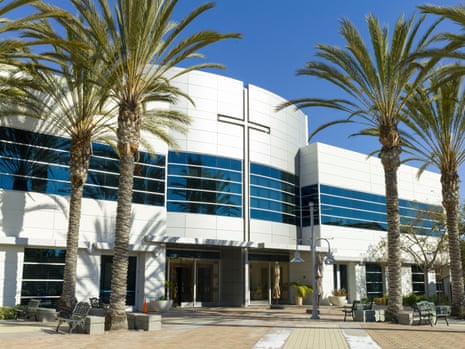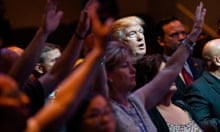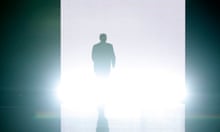“I started photographing megachurches as an oppositional idea,” explains Lisa Anne Auerbach, a California photographer and artist. “I had been doing a series about small freestanding businesses [encapsulating] this idea of America: you’re an individual, you hang up your shingle, you pick yourself up by your bootstrap, and become your own fantasy. I was thinking about megachurches being another part of the American dream – faith and family and community.”
Using a database published by Hartford Seminary, a theological college in Connecticut, Auerbach catalogued megachurches – “and I use their definition for this”, she stresses – in Protestant denominations, which claim to have weekly congregations of over 2,000 people. Auerbach also subscribed to Outreach magazine, a publication aimed at those who run churches, which has listings of megachurches. The top 50 in the country have more than 10,000 worshippers a week.

Auerbach’s project was driven by her bafflement at America’s evangelical Christian demographic. “We hear about America being 90% Christian, or some crazy number, and as an artist living in Los Angeles, that’s not what I’m in touch with at all,” she says. “I had been reading about megachurches in the press, mostly in relationship to politics, and thinking: who are these people that are going to these places, that are buying this conservative agenda?”
With anthropological curiosity, Auerbach started exploring the phenomenon in proximity to her home, but always brought her camera when travelling elsewhere. So far, she has photographed megachurches in Florida, Arizona, Michigan, Illinois, North Carolina, South Carolina and California.
Initially planning to make big prints of the megachurches, she reasoned: “If you walk into a room full of them, it’s going to look like a recruitment – the opposite of what I wanted.” So she decided to make a jumbo zine, which she dubs a “megazine”, scaling up the traditional half-letter-size format to 60in. She has made three such megazines in total: one on psychics, two on megachurches.

Auerbach’s megachurch megazine is currently on view in a Paris exhibition called Wasteland: New Art from Los Angeles, a reference to the famed TS Eliot poem. The relationship between architecture, landscape and religion seems particularly strange from a European perspective. The conception of the cathedral is not only where one goes to be spiritual or commune with God, but to feel awe through the grandeur of the architecture and the building’s history. Comparatively, the US megachurch buildings are stripped wholesale of that sense of wonder and connection to the past; they are also far from the focal point of a city.
“Notre Dame is a cathedral in the center of the city,” says Auerbach. “Whereas these churches, although they’re very powerful, are hidden. The reason they’re hidden, I found, is that they’re camouflaged. They look like places we just drive by. They’re in office parks; they’re in former big box stores. I thought that was fascinating: I don’t even know what to look for. That was the impetus to say: what is this thing?”

In tandem with the photographs, Auerbach provides statistics on purported congregation size and denomination, as well as church location and name. Some nomenclature is so fanciful as to seem fabricated (or at least worthy of the Onion): Love International Ministries, Potential Church, Life Changers International, Pilgrim Rest.
Auerbach jotted down personal anecdotes about her experience, to “flesh out the photographs a little bit”. She noted bad puns, such as “thou shalt not park here” signs in a lot, and a church coffee shop called He Brews. She observed that the sign reading “chapel” was the exact dimension and typeface as the one adjacently announcing “restrooms”. She noticed a mosaic cross juxtaposed directly above a garbage can, and a church parking lot “suspiciously filled with single men sitting in their cars and pickup trucks”. Encountering an outdoor baptismal tub, she wondered if people ever repurposed it for a refreshing summer dip (“If you’re already baptized, can you do it just to cool down?”) She stumbled on a drive-through prayer center in Arizona, where members “prayed for my photo project while I took the photo”.

The images are characterized by an acute eeriness – Auerbach purposefully photographed the spaces on weekdays, while more or less vacant. “I don’t want the presence of people to get in the way of looking at the space,” she says. Auerbach also provides field notes about the church’s accessibility (or lack thereof), who was lurking and the general vicinity: billboards, furniture stores, McDonald’s, minimarts, mega-mansions, grim apartment buildings, soccer fields, freeways and expressways.
From the outset, Auerbach’s mission was above all a visual one. Her photographic influences – William Christenberry, Walker Evans, Lewis Baltz, (“all the New Topographics stuff”) – are apparent: like them, she provides a matter-of-fact look at the commonplace American landscape. “I wanted them to be traditionally beautiful photos, despite being weird,” she emphasizes. “I knew these places are around, but I was like: have I seen them? Would I recognize them? Is it part of my commute and I don’t acknowledge it, because I don’t know what to look for? It came from curiosity.”

Her descriptions of the churches she encountered range from funny to uneasy. She finds edifices evocative of a hospital, greenhouse, plastic toy, warehouse, Old West movie set, bunker and low brown turtle. Recurring adjectives include bland, industrial, sterile and Disney-like; materials include stucco, tile, stone, concrete, cinder block and unsightly brick. The drab architecture reflects the monolithic nature of church theologies: “Unlike the small businesses, which felt very individualistic, and about creating your own world view, the church felt more about power, about converting people, so they could have wealth.”
The featureless buildings concealed in plain sight indicate the way evangelical America works: disguised within the quotidian landscape, pumping commercial spaces with pious significance. “WHERE WILL YOU SPEND ETERNITY?” one of the photographed places of worship challenges ominously. It’s a loaded question for something just off the expressway.

In the context of the election and the fever pitch of conservative voices, the project takes on added resonance – on an electoral level as well as an anthropological one. Auerbach says: “I started photographing soon after the 2008 election, because I started reading about how megachurch members were determining polls in various places. It’s against the law for churches to promote candidates, but they preach around that, as closely as they can.” Auerbach is thinking of driving across the country during the upcoming national election, but admits: “I don’t know if I can handle it.” She is thinking of making a megazine about cats instead.










Comments (…)
Sign in or create your Guardian account to join the discussion